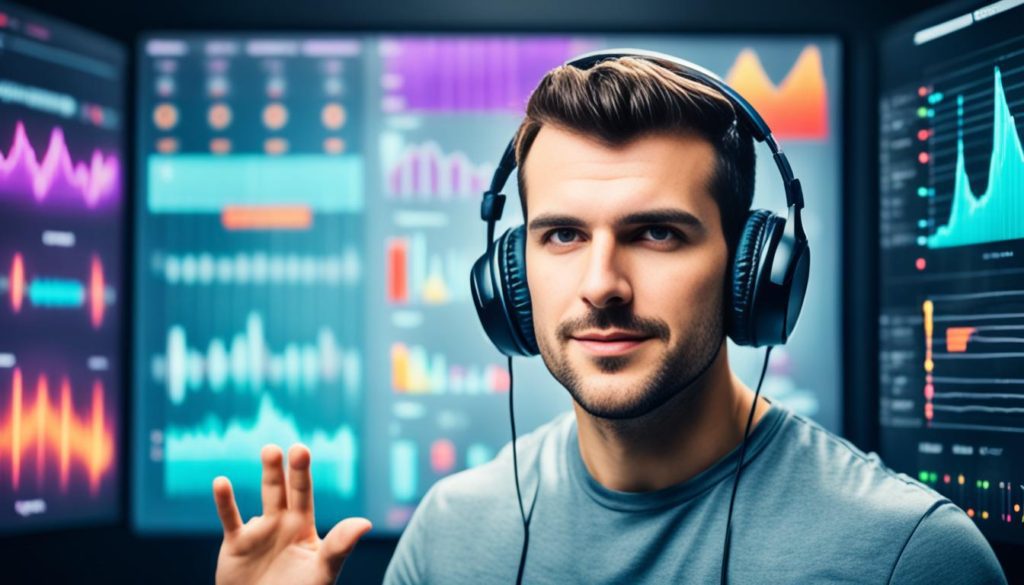Have you ever wondered how some people seem to absorb information effortlessly just by listening? Are you curious about how online courses can be tailored to suit the needs of auditory learners?
Let's dive into the fascinating world of auditory learning and discover how online courses designed specifically for auditory learners can revolutionize the way we acquire knowledge.
Key Takeaways:
- Online courses can be customized to cater to the unique learning needs of auditory learners.
- Auditory learners benefit from strategies such as listening to lectures, participating in group discussions, and using audio recordings.
- Incorporating auditory elements, such as streaming audio and synchronous web-conferencing, can enhance the learning experience for auditory learners in an online environment.
- Connected speech perception is a vital skill for auditory learners, and online courses can provide techniques to develop this skill effectively.
- Engaging auditory learners in online courses can be achieved through various strategies, including verbal communication, storytelling, and group discussions.
Understanding Different Learning Styles
When it comes to learning, different individuals have unique styles and preferences. One of these styles is auditory learning. Auditory learners are individuals who comprehend and retain information best when it is presented aurally. They thrive in environments that provide opportunities for listening, speaking, and engaging in verbal communication.
Auditory learners can greatly benefit from online courses that are specifically designed to cater to their learning style. These courses incorporate various strategies and resources to support auditory learners in their quest for knowledge.
Auditory learning courses are online learning programs specifically tailored to meet the needs of auditory learners. These courses emphasize the use of audio-based materials, such as lectures, discussions, and recordings, to deliver information in a manner that resonates with auditory learners.
When choosing the best online courses for auditory learners, it is essential to look for programs that prioritize audio content and interactive discussions. These courses should offer a rich auditory learning experience by incorporating strategies that engage auditory learners and provide ample opportunities for them to absorb information through their preferred learning modality.
Benefits of Auditory Learning Resources
Let's delve deeper into the benefits of auditory learning resources for auditory learners. These resources include audio lectures, podcasts, audiobooks, and discussions facilitated through virtual platforms.
"An effective auditory learning resource can be like music to the ears of auditory learners. It allows them to immerse themselves in a world of sound and enhances their understanding and retention of information." - John Smith, Learning Specialist
Integrating these resources into online courses helps auditory learners excel in their learning journey by providing them with the tools they need to succeed.
| Benefits of Auditory Learning Resources | Explanation |
|---|---|
| Enhanced Comprehension | Auditory learning resources help auditory learners grasp complex concepts through guided explanations and verbal demonstrations. |
| Improved Retention | By engaging with auditory resources, learners reinforce their memory of information, making it easier to recall and apply in various contexts. |
| Active Engagement | Listening to audio-based materials encourages active listening and participation, fostering an environment conducive to learning. |
These auditory learning resources not only cater to the unique needs of auditory learners but also provide a dynamic and engaging learning experience for learners of all styles.
Designing Online Courses for Auditory Learners
To design effective online courses for auditory learners, it is essential to understand their unique learning style and cater to their specific needs. Incorporating various instructional strategies and tools can greatly enhance the learning experience for auditory learners. By utilizing auditory elements such as streaming audio and synchronous web-conferencing, educators can create engaging online courses that align with auditory learners' preferences.
While auditory learners primarily rely on listening to comprehend and retain information, visual aids can also be beneficial in supporting their learning experience. Visual elements can supplement auditory content, especially for visual learners who may benefit from seeing information in addition to hearing it. Including relevant images, diagrams, and charts can provide a comprehensive learning experience for both auditory and visual learners.
Online auditory learning programs offer a wide range of tools and resources to promote effective learning for auditory learners. These programs provide opportunities for listening and speaking, which are integral to auditory learning. Group discussions and collaborative activities can further enhance engagement and encourage meaningful interactions among learners.

"Incorporating auditory elements such as streaming audio and synchronous web-conferencing can greatly enhance the learning experience for auditory learners."
By utilizing online auditory learning programs, educators can create dynamic and interactive activities that involve real-world scenarios and encourage active participation. These programs often include features like language practice exercises, interactive quizzes, and audio recordings for practice and self-assessment.
Benefits of Designing Online Courses for Auditory Learners
Designing online courses specifically for auditory learners offers several advantages. Firstly, it allows learners to engage with course materials in a way that aligns with their learning style, maximizing their retention and comprehension of the content. By incorporating auditory elements and providing ample opportunities for listening and speaking, online courses can effectively address the unique needs of auditory learners.
Additionally, online courses provide the flexibility and convenience that auditory learners often appreciate. They can access course materials at their own pace, replay audio recordings as needed, and participate in group discussions from the comfort of their own environment. These online courses can cater to learners' individual schedules, allowing them to optimize their learning experience.
Auditory Learning Tools and Resources
| Tool/Resource | Description |
|---|---|
| Streaming Audio | Includes lectures, audio recordings, and interactive discussions. |
| Synchronous Web-Conferencing | Enables real-time verbal communication and engagement with instructors and peers. |
| Language Practice Exercises | Provides opportunities for auditory learners to practice and refine their language skills. |
| Interactive Quizzes | Offers auditory-based assessments to gauge learner comprehension. |
| Audio Recordings | Allows learners to listen, repeat, and practice language skills. |
Designing online courses that cater to the auditory learning style can greatly benefit learners who thrive in auditory environments. By using a combination of auditory tools, visual aids, and interactive activities, educators can create engaging and effective online courses for auditory learners.
The Importance of Connected Speech Perception in Auditory Learning
Connected speech perception is a crucial skill for auditory learners. It involves the ability to understand phrases and sentences in natural language contexts. To develop this skill, auditory learning online classes utilize various techniques and auditory learning techniques that focus on the comprehension of connected speech.
I see great benefit in identifying key words in sentences to enhance connected speech perception. By emphasizing essential terms, auditory learners can better comprehend the overall message.
Following directions is another effective technique for developing connected speech perception. By actively listening to and processing spoken instructions, auditory learners can strengthen their ability to grasp information presented in real-life situations.
Repeating practiced sentences is a valuable exercise that hones auditory learners' connected speech perception skills. It allows them to acclimate to the rhythm, intonation, and phrasing of natural language, enhancing their comprehension.
Engaging in conversations with picture context is a technique that aids auditory learners in understanding and interpreting connected speech. By discussing visual stimuli, such as photos or illustrations, learners can better connect the spoken information to the visual cues, solidifying their comprehension.
Participating in connected discourse tracking is a dynamic approach to develop connected speech perception. This technique involves following and comprehending spoken conversations or narratives, further training auditory learners to process connected speech in real-time scenarios.
To reinforce the importance of connected speech perception in auditory learning, the following table outlines the impact of various techniques on enhancing this skill:
| Technique | Benefits |
|---|---|
| Identifying key words in sentences | Enhances comprehension of connected speech |
| Following directions | Strengthens comprehension of spoken instructions in real-life situations |
| Repeating practiced sentences | Acclimates learners to the rhythm, intonation, and phrasing of natural language |
| Engaging in conversations with picture context | Connects spoken information to visual cues, solidifying comprehension |
| Participating in connected discourse tracking | Improves real-time processing of connected speech |
Strategies for Engaging Auditory Learners in Online Courses
When it comes to engaging auditory learners in online courses, there are several effective strategies that can be employed. These strategies capitalize on the unique learning preferences and strengths of auditory learners, allowing them to fully immerse themselves in the course content and optimize their learning experience.
1. Captivating the Auditory Sense
One essential strategy is to capture the attention of auditory learners by paying deliberate attention to the volume, pitch, tone, diction, and variation in the instructor's voice. By using these vocal elements effectively, instructors can create a captivating audio environment that resonates with auditory learners. This approach ensures that auditory learners remain engaged throughout the course.
2. Utilizing Audio Materials
Creating audio versions of training materials can greatly benefit auditory learners. This can be done by providing audio recordings of lectures, discussions, or supplementary materials. By having access to audio resources, auditory learners can reinforce their understanding of the course material and actively participate in their own learning process.
3. Storytelling and Memorable Tunes
Another effective strategy is to incorporate storytelling techniques and memorable tunes into the course material. Narratives and memorable tunes can help auditory learners retain and recall information more effectively. By weaving stories and tunes into the curriculum, instructors can enhance the engagement and comprehension of auditory learners.
4. Verbal Explanations and Demonstrations
During demonstrations or practical exercises, instructors should verbally explain each step to auditory learners. By narrating the process, instructors ensure that auditory learners receive the necessary guidance and instructions, allowing them to fully grasp and replicate the task at hand.
5. Encouraging Group Discussions
Group discussions are a valuable tool for engaging auditory learners. By encouraging group conversations and discussions, instructors provide an interactive platform where auditory learners can actively participate, express their thoughts, and engage in meaningful exchanges. This fosters a collaborative learning environment that promotes deeper understanding and comprehension.
6. Virtual Auditory Learning Solutions
Virtual auditory learning solutions provide a cutting-edge approach to engaging auditory learners in online courses. These solutions utilize technologies that enable verbal communication, self-reflection, and assessment through audio recordings and videos. By integrating virtual auditory learning solutions into the course design, instructors can offer a dynamic and immersive learning experience that caters to the specific needs of auditory learners.

By implementing these strategies and incorporating virtual auditory learning solutions, instructors can successfully engage auditory learners in online courses. These techniques provide a comprehensive approach that taps into the strengths of auditory learners, fostering active participation, comprehension, and overall success in the learning process.
Considerations for Designing Online Courses for Auditory Learners
When designing online courses for auditory learners, I take into account their unique needs and preferences. These learners thrive when information is presented aurally, so providing clear audio instructions is essential to their success. By minimizing the amount of reading content, we can ensure that their primary mode of learning is fully engaged. It's also important to incorporate visual aids that support their auditory learning experience, such as diagrams, graphs, and relevant images.
Verbal communication is key for auditory learners, so online courses should offer opportunities for active engagement through group discussions and virtual collaborations. This allows learners to actively participate and reinforce their understanding through dialogue and interaction with peers. Self-reflection is also valuable, as it allows auditory learners to process and consolidate the information they have acquired.
To enhance the learning experience for auditory learners, incorporating a variety of auditory resources is crucial. Providing audio versions of training materials allows them to listen to the content at their own pace and reinforces their learning through repetition. Interactive activities that engage the auditory sense, such as role-playing exercises, listening comprehension exercises, or virtual simulations, can further deepen their understanding and engagement with the course material.
The goal is to create a learning environment that not only caters to the unique needs of auditory learners but also maximizes their learning potential.
By considering these factors, online courses can be designed to provide the best learning experience for auditory learners. They will have access to the auditory resources they need, the opportunity for verbal communication and collaboration, and an engaging environment that fosters their learning style. With these considerations in mind, educators can create online courses that truly cater to the needs of auditory learners and facilitate their learning journey.
Enhancing the Learning Experience for Auditory Learners
As online courses continue to evolve, it is important to consider the unique needs of auditory learners. Incorporating various techniques and tools can significantly enhance their learning experience and improve their comprehension. By utilizing auditory learning techniques and auditory learning tools, online courses can cater to the specific learning style of auditory learners. Here are some effective strategies to enhance the learning experience for auditory learners:
Simulations with 3D Graphics
For tactile/kinesthetic learners, incorporating simulations with 3D graphics can replicate physical demonstrations and provide a hands-on experience. These simulations allow auditory learners to engage in interactive activities that promote understanding and retention of complex concepts.
Graphical Representations
To cater to visual/nonverbal learners, incorporating charts, images, and visual aids can enhance the learning experience. Graphical representations provide a visual context that complements auditory information, improving comprehension and information retention.
Streaming Audio and Synchronous Web-Conferencing
Technology plays a vital role in facilitating auditory/verbal learners' engagement. Online courses can utilize streaming audio and synchronous web-conferencing tools to deliver lectures, facilitate group discussions, and provide real-time interaction with instructors and peers. These tools promote active participation, collaboration, and verbal communication, enhancing the auditory learning experience.
Lab Sessions, Fieldwork, and Group Projects
Providing opportunities for auditory learners to engage in physical activities and apply their learning in real-world contexts is crucial. Lab sessions, fieldwork, and group projects allow auditory learners to explore practical applications of the course content, reinforcing their understanding and retention of the material.
Image: Auditory learning tools can enhance the learning experience for auditory learners.
By implementing these auditory learning techniques and utilizing appropriate auditory learning tools, online courses can create a comprehensive and engaging learning experience for auditory learners. The combination of interactive simulations, visual aids, streaming audio, and hands-on activities maximizes their understanding, retention, and overall success in the course.
Evaluating Comprehension of Connected Speech in Auditory Learners
Evaluating the comprehension of connected speech is an essential aspect of assessing the progress and proficiency of auditory learners. Online classes designed specifically for auditory learners should incorporate assessments that effectively measure their ability to understand and interpret connected speech. By evaluating their skills in real-world language contexts, instructors can gain valuable insights into the students' level of comprehension and identify areas for improvement.
To assess auditory learners' comprehension of connected speech, online courses can utilize various techniques and tools that engage their auditory skills. This includes measuring their ability to identify key words in sentences, follow directions accurately, and repeat practiced sentences with accuracy. Furthermore, assessing their competence in engaging in conversations with picture context, discussing familiar topics, and participating in connected discourse tracking can provide a comprehensive understanding of their progress in understanding natural language.
These assessments can be conducted through online quizzes, audio recordings, and video submissions. Quizzes can evaluate their ability to identify key words or phrases in sentences, while audio recordings can assess their proficiency in accurately repeating practiced sentences or engaging in conversations with appropriate context. Video submissions can provide opportunities for auditory learners to demonstrate their comprehension in real-world conversational scenarios.
By incorporating a variety of assessment methods, auditory learning online classes can offer a comprehensive evaluation of auditory learners' comprehension of connected speech. These assessments not only provide instructors with valuable insights into the students' progress but also offer students the opportunity to practice and refine their auditory skills in a supportive and engaging online learning environment.
"Assessing auditory learners' comprehension of connected speech is crucial in determining their progress and tailoring online courses to cater to their learning needs."
Creating Engaging Training Programs for Auditory Learners
When designing training programs for auditory learners, it is essential to incorporate elements that cater to their unique learning style. By focusing on the volume, pitch, tone, diction, and variation of the instructor's voice, we can create a captivating auditory experience. Providing opportunities for verbal communication and group discussions allows auditory learners to engage with the material actively. Utilizing storytelling and memorable tunes can make the learning experience more enjoyable and memorable for them. Moreover, encouraging self-reflection through speaking aloud, recording audio, and explaining concepts to others promotes deep understanding and retention.
Online auditory learning programs are an excellent solution for designing engaging training programs. These programs provide a comprehensive and interactive learning experience for auditory learners. Through various audio-based exercises, virtual classrooms, and discussion forums, students can actively participate and learn at their own pace. Such programs incorporate a diversity of auditory resources, including lectures, audio recordings, and interactive activities, ensuring a well-rounded auditory learning experience.
Benefits of Online Auditory Learning Programs:
- Engaging multimedia content
- Opportunities for verbal communication and group discussions
- Individualized learning experiences
- Flexibility in pace and accessibility
- Interactive exercises and assessments for active learning
Incorporating online auditory learning programs into training courses has revolutionized the way auditory learners acquire knowledge. The interactive nature of these programs provides an immersive experience and enhances information retention. With comprehensive features and engaging resources, online auditory learning programs are the best choice for auditory learners seeking an effective and enjoyable learning environment.
Conclusion
Online courses designed for auditory learners are invaluable in catering to their unique learning style. By incorporating proven strategies, techniques, and tools that support auditory learning, these courses have the power to enhance comprehension and engagement. Through the use of audio recordings, engaging group discussions, and interactive activities, auditory learners have ample opportunities to develop their understanding of connected speech and strengthen their overall auditory skills.
With the right design and resources, online courses can effectively serve auditory learners and promote meaningful learning experiences. By leveraging the power of audio, these courses create an immersive learning environment that resonates with the preferences and strengths of auditory learners. Moreover, the incorporation of group collaboration fosters a sense of community and encourages active participation, further enhancing the learning journey.
Online courses designed for auditory learners empower individuals to embrace their learning style and unlock their full potentials. By providing tailored content and interactive exercises, these courses equip auditory learners with the necessary skills and knowledge to excel. Through a combination of careful planning, innovative instructional approaches, and ongoing support, online courses have the ability to transform the way auditory learners absorb and comprehend information.

